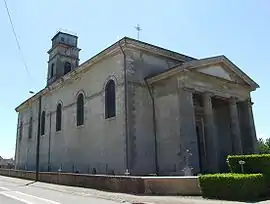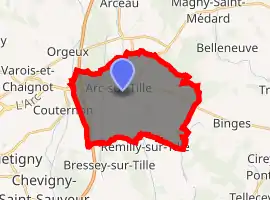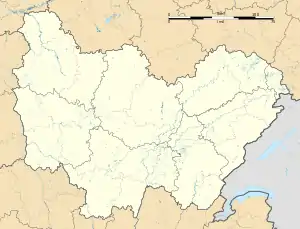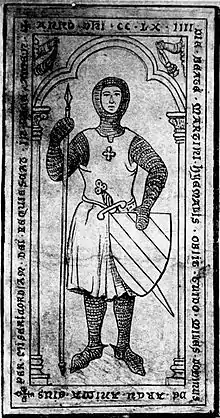Arc-sur-Tille
Arc-sur-Tille is a commune in the Côte-d'Or department in the Bourgogne-Franche-Comté region of eastern France.
Arc-sur-Tille | |
|---|---|
 The Church of Saint Martin | |
.svg.png.webp) Coat of arms | |
Location of Arc-sur-Tille 
| |
 Arc-sur-Tille  Arc-sur-Tille | |
| Coordinates: 47°20′38″N 5°11′33″E | |
| Country | France |
| Region | Bourgogne-Franche-Comté |
| Department | Côte-d'Or |
| Arrondissement | Dijon |
| Canton | Saint-Apollinaire |
| Intercommunality | Norge et Tille |
| Government | |
| • Mayor (2020–2026) | Patrick Morelière |
| Area 1 | 22.71 km2 (8.77 sq mi) |
| Population (2017-01-01)[1] | 2,670 |
| • Density | 120/km2 (300/sq mi) |
| Time zone | UTC+01:00 (CET) |
| • Summer (DST) | UTC+02:00 (CEST) |
| INSEE/Postal code | 21021 /21560 |
| Elevation | 209–241 m (686–791 ft) |
| 1 French Land Register data, which excludes lakes, ponds, glaciers > 1 km2 (0.386 sq mi or 247 acres) and river estuaries. | |
The inhabitants of the commune are known as Acétillois or Acétilloises[2]
Geography
Arc-sur-Tille is located approximately 12 kilometres by road east of Dijon by road D70 which continues north-west to Magny-Saint-Medard. The A31 autoroute passes through the west of the commune from north to south with exit ![]() 4 in the commune west of the town. The commune can also be accessed from Remilly-sur-Tille in the south by road D34 which continues north to Chateau d'Arcelot. Road D961 also goes east from the village to Étevaux. Apart from the large sized village occupying some 15% of the commune, the rest of the area is almost entirely farmland.[3]
4 in the commune west of the town. The commune can also be accessed from Remilly-sur-Tille in the south by road D34 which continues north to Chateau d'Arcelot. Road D961 also goes east from the village to Étevaux. Apart from the large sized village occupying some 15% of the commune, the rest of the area is almost entirely farmland.[3]
Geology
The commune is located on a marshy plain
Hydrography
The commune is traversed from north to south by the Tille, a tributary of the Saône. It has often flooded in the past, overwhelming and damaging the village and crops.
The Lake of Arc-sur-Tille, west of the town, is a former gravel pit converted since 2002 to create the largest sandy beach in Burgundy. It is very popular in summer with swimmers and it allows many water activities (sailing, canoeing, water skiing and fishing basins reserved). The lake water is of excellent quality.
Neighbouring communes and villages
History
The Arc-sur-Tille Parish in the 17th century had its name corrupted by the vulgar pronunciation Astille.[4] The village was a bailiwick, revenue office, and storehouse for salt from Dijon. Depends on both the Bishop of Chalon-sur-Saône and the Archdeacon of Oscheret. Three-quarters of the tithe was for the lord and the rest for the priest. It was 11, 12, or 13 bundles of all kinds of grain.
The patron saint of the parish was Saint Martin, Archbishop of Tours, whose principal feast is not on 11 November, the day of his death, but on 4 July, the day of the Translation of his relics; the dedication of the church is celebrated the Sunday before 3 August.
Abbots from the Abbey of Saint-Étienne of Dijon have the right to preach at this church, from Gautier, Bishop of Chalon-sur-Saône who gave this right to them in 1117. Jotsalde or Joussaud, his successor in the bishopric, ratified this in the same year in a full synod of Tournus and it was subsequently confirmed by various popes in 1124, by Callistus II in 1139, by Innocent II, then in 1156, 1185, 1238, 1245 and 1290. This land with full justice rights was raised to a marquisate. The only trade was in coal. It grew wheat, barley, oats and conceau in vineyards and meadows that yielded a very bad hay. The 138 inhabitants were very poor except for three or four.[5] In 1260 Henry de Vergy declared tenure in fief with allegiance to the Duke of Burgundy the fiefs of Bere, Arc-sur-Tille, and Janle. The village was given the name of a local family. Maifroi of Archo gave the enclosed land within the lordship of Arc to the abbot of Saint-Étienne and also gave him the right of heating from the wood in 1115.
It was in the 14th century that the last heir of the lordship, Jehanne d'Arc, took as her husband Eudes de Saulx and thus the land entered the House of Saulx-Tavannes where it still was in the 18th century. The levy cost the States the sum of 45,000 livres in 1614. Before the French Revolution there were four fairs a year: on 4 January, March, May, and September. In 1636 Arc was burned by Matthias Gallas and the castle was plundered and destroyed.
On 9 February 1650 near Arc there was a battle between the troops of the King, led by the Marquis de Tavannes and the Count, his nephew, who commanded those of the Prince of Conde, then a prisoner at Le Havre. The King was defeated and lost all his equipment.
Heraldry
.svg.png.webp) Arms of Arc-sur-Tille |
Blazon: Bendy of Six Or and Gules. |
Administration
- Mayors under the Ancien Régime
- 1115 av - Maifroi de Archo
- 1314 - Jeahan d'Arc Knight, Squire of Arc
- 1329 - Jehan d'Arc Knight, Squire of Arc
- 1331 - Guy d'Arc and his wife Alix de Nus
- 1380 - Humbert d'Arc, Knight of Arc
- 14th century- Jehanne d'Arc husband, Eudes de Saulx
- 1543 - Elyon de Mailly, Lord of Arc, Charette-Varennes, and Terrans
- 1650 - Marquis de Tavannes
- 1666 - Jacques de Saulx, Coount of Tavanne, bailiff of Dijon
List of Successive Mayors[6]
| From | To | Name | Party | Position |
|---|---|---|---|---|
| 2001 | 2008 | François Mauge | SE | |
| 2008 | 2008 | Daniel Viard | SE | |
| 2008 | 2026 | Patrick Morelière | SE |
(Not all data is known)
Demography
In 2017 the commune had 2,670 inhabitants.
|
| ||||||||||||||||||||||||||||||||||||||||||||||||||||||||||||||||||||||||||||||||||||||||||||||||||||||||||||||||||
| Source: EHESS[7] and INSEE[8] | |||||||||||||||||||||||||||||||||||||||||||||||||||||||||||||||||||||||||||||||||||||||||||||||||||||||||||||||||||
Sites and Monuments
Civil Heritage
- The Château d'Arc-sur-Tille was looted and destroyed in 1636 by Galas
- The Moulin sur la Tille (Mill on the Tille)
- The Town Hall contains a Federation Banner (1790)
 which is registered as an historical object.[9]
which is registered as an historical object.[9]
Religious Heritage
The Church of Saint Martin was built during the French Restoration (1820-1830) in the Neo-classical style. In 1989 the building was in such a state of disrepair that it had to close. The former municipality, despite opposition from religious authorities, had planned to demolish the building but due to the action of the UEPA association, the first installment of rehabilitation work was launched in April 2013. A national subscription was raised through the Heritage Foundation to enable the financing of the second phase of work that will eventually reopen the Church of Saint Martin to the public. The church contains several items that are registered as historical objects:
Notable people linked to the commune

- Henri d'Arc, dean of the Sainte-Chapelle of Dijon, died in 1238; he was the nephew of Hugues d'Arc, abbot of St. Benignus.
- Hugues d'Arc, Abbot of the Abbey of La Chaise-Dieu in 1306
- Hugues d'Arc, 73rd Abbot of the Abbey of Saint-Benign of Dijon from 1269 to 1300
- Jehan d'Arc, two Knights, Lords of Arc in 1314 & 1329, their epitaphs are in the parish church.
- Louis XIV, King of France, stayed in Arc-sur-Tille on 19 June 1674 after the conquest of Franche-Comté.
- Nicolas Jacquemard (1771-1835), general of the armies of the Republic and the Empire.
- Stéphane Tarnier (1828-1897), French obstetrician, inventor of several obstetric instruments, including Tarnier forceps.[16] He recommended to his disciples at the time to implement aseptic practices during childbirth recommended by Semmelweis and Lister. The majority of these works in obstetrics are grouped in a book entitled Treatise of the Art of Childbirth by Prof. S Tarnier and Prof. P Budin. In the main street of Arc-sur-Tille his former residence (La Clochette) bears his name. To the south of Arc-sur-Tille a fountain also bears his name.
- Albin Roussin (1781-1854), Baron Albin Reine Roussin, born at Dijon; Admiral, Savant, Minister of the Navy.
See also
Bibliography
- Claude Courtépée, Historical Description of the Duchy of Burgundy ..., Dijon, chez Causse imprimeur, Vol. II, p. 312-314. (in French)
External links
References
- "Populations légales 2017". INSEE. Retrieved 6 January 2020.
- Inhabitants of Côte-d'Or (in French)
- Google Maps
- Claude Fyot de la Marche, History of the Abbey and Collegial Church of Saint Estienne of Dijon, Dijon, 1696, Chapter II, p. 316 (in French)
- Investigation by Steward Bouchu (1666-1669), deposited at the Bureau of Finance (in French)
- List of Mayors of France
- Des villages de Cassini aux communes d'aujourd'hui: Commune data sheet Arc-sur-Tille, EHESS. (in French)
- Population en historique depuis 1968, INSEE
- Ministry of Culture, Palissy PM21000041 Federation Banner (in French)

- Ministry of Culture, Palissy PM21000040 Painting: Saint Antoine the Hermit (in French)

- Ministry of Culture, Palissy PM21000039 Painting: Ecce homo (in French)

- Ministry of Culture, Palissy PM21000038 Painting: Saint Nicolas (in French)

- Ministry of Culture, Palissy PM21000037 Statue: Saint Ursula (in French)

- Ministry of Culture, Palissy PM21000036 Tombstone for Louis de Lenoncourt (in French)
- Ministry of Culture, Palissy IM21005927 Furniture in the Church (in French)
- Stéphane Tarnier: Chirurgien French Obstetrician (in French)
| Wikimedia Commons has media related to Arc-sur-Tille. |